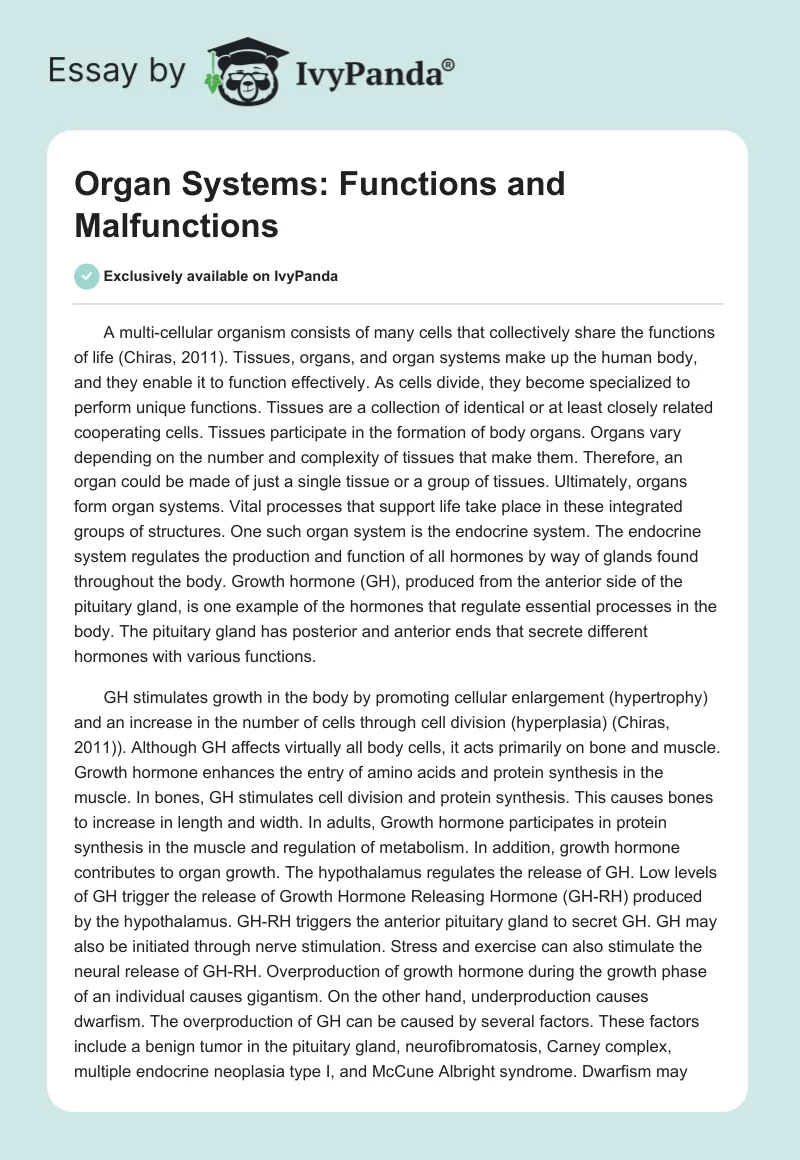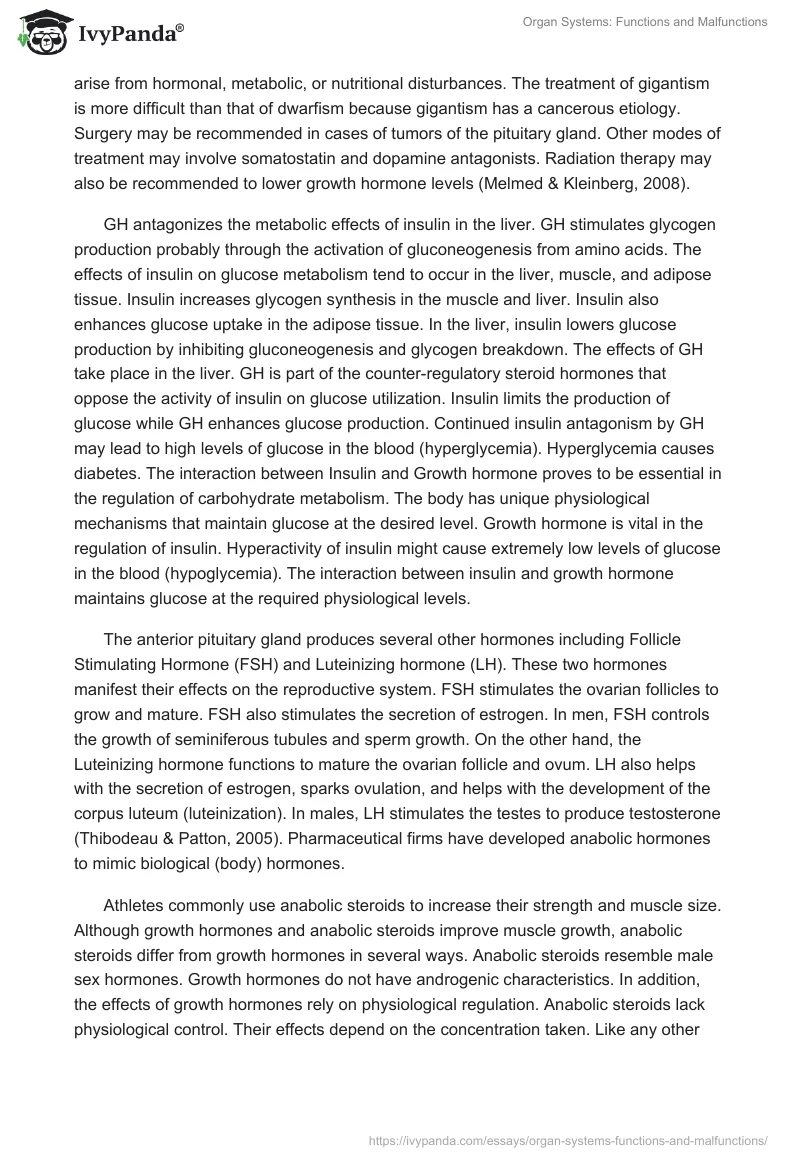A multi-cellular organism consists of many cells that collectively share the functions of life (Chiras, 2011). Tissues, organs, and organ systems make up the human body, and they enable it to function effectively. As cells divide, they become specialized to perform unique functions. Tissues are a collection of identical or at least closely related cooperating cells. Tissues participate in the formation of body organs. Organs vary depending on the number and complexity of tissues that make them. Therefore, an organ could be made of just a single tissue or a group of tissues. Ultimately, organs form organ systems. Vital processes that support life take place in these integrated groups of structures. One such organ system is the endocrine system. The endocrine system regulates the production and function of all hormones by way of glands found throughout the body. Growth hormone (GH), produced from the anterior side of the pituitary gland, is one example of the hormones that regulate essential processes in the body. The pituitary gland has posterior and anterior ends that secrete different hormones with various functions.
GH stimulates growth in the body by promoting cellular enlargement (hypertrophy) and an increase in the number of cells through cell division (hyperplasia) (Chiras, 2011)). Although GH affects virtually all body cells, it acts primarily on bone and muscle. Growth hormone enhances the entry of amino acids and protein synthesis in the muscle. In bones, GH stimulates cell division and protein synthesis. This causes bones to increase in length and width. In adults, Growth hormone participates in protein synthesis in the muscle and regulation of metabolism. In addition, growth hormone contributes to organ growth. The hypothalamus regulates the release of GH. Low levels of GH trigger the release of Growth Hormone Releasing Hormone (GH-RH) produced by the hypothalamus. GH-RH triggers the anterior pituitary gland to secret GH. GH may also be initiated through nerve stimulation. Stress and exercise can also stimulate the neural release of GH-RH. Overproduction of growth hormone during the growth phase of an individual causes gigantism. On the other hand, underproduction causes dwarfism. The overproduction of GH can be caused by several factors. These factors include a benign tumor in the pituitary gland, neurofibromatosis, Carney complex, multiple endocrine neoplasia type I, and McCune Albright syndrome. Dwarfism may arise from hormonal, metabolic, or nutritional disturbances. The treatment of gigantism is more difficult than that of dwarfism because gigantism has a cancerous etiology. Surgery may be recommended in cases of tumors of the pituitary gland. Other modes of treatment may involve somatostatin and dopamine antagonists. Radiation therapy may also be recommended to lower growth hormone levels (Melmed & Kleinberg, 2008).
GH antagonizes the metabolic effects of insulin in the liver. GH stimulates glycogen production probably through the activation of gluconeogenesis from amino acids. The effects of insulin on glucose metabolism tend to occur in the liver, muscle, and adipose tissue. Insulin increases glycogen synthesis in the muscle and liver. Insulin also enhances glucose uptake in the adipose tissue. In the liver, insulin lowers glucose production by inhibiting gluconeogenesis and glycogen breakdown. The effects of GH take place in the liver. GH is part of the counter-regulatory steroid hormones that oppose the activity of insulin on glucose utilization. Insulin limits the production of glucose while GH enhances glucose production. Continued insulin antagonism by GH may lead to high levels of glucose in the blood (hyperglycemia). Hyperglycemia causes diabetes. The interaction between Insulin and Growth hormone proves to be essential in the regulation of carbohydrate metabolism. The body has unique physiological mechanisms that maintain glucose at the desired level. Growth hormone is vital in the regulation of insulin. Hyperactivity of insulin might cause extremely low levels of glucose in the blood (hypoglycemia). The interaction between insulin and growth hormone maintains glucose at the required physiological levels.
The anterior pituitary gland produces several other hormones including Follicle Stimulating Hormone (FSH) and Luteinizing hormone (LH). These two hormones manifest their effects on the reproductive system. FSH stimulates the ovarian follicles to grow and mature. FSH also stimulates the secretion of estrogen. In men, FSH controls the growth of seminiferous tubules and sperm growth. On the other hand, the Luteinizing hormone functions to mature the ovarian follicle and ovum. LH also helps with the secretion of estrogen, sparks ovulation, and helps with the development of the corpus luteum (luteinization). In males, LH stimulates the testes to produce testosterone (Thibodeau & Patton, 2005). Pharmaceutical firms have developed anabolic hormones to mimic biological (body) hormones.
Athletes commonly use anabolic steroids to increase their strength and muscle size. Although growth hormones and anabolic steroids improve muscle growth, anabolic steroids differ from growth hormones in several ways. Anabolic steroids resemble male sex hormones. Growth hormones do not have androgenic characteristics. In addition, the effects of growth hormones rely on physiological regulation. Anabolic steroids lack physiological control. Their effects depend on the concentration taken. Like any other synthetic molecules, anabolic steroids undergo renal clearance once their function ends.
References
Chiras, D. (2011). Human Biology. Massachusetts: Jones and Barlett.
Melmed, S., and Kleinberg, D. (2008). William’s Book of Endocrinology. Philadelphia: Saunders Elsevier.
Thibodeau, A., and Patton, K. (2005). The Human Body in Health and Disease. St. Louis: Elsevier/Mosby.


